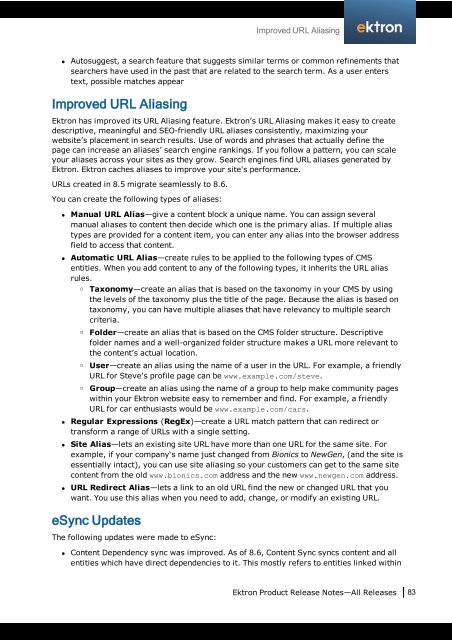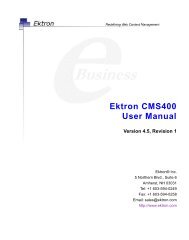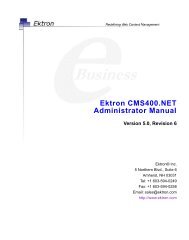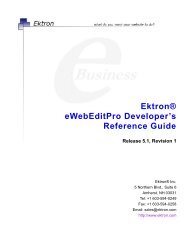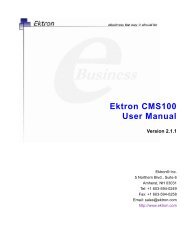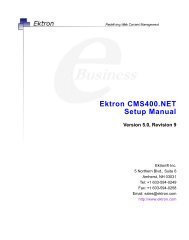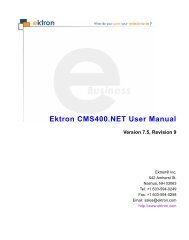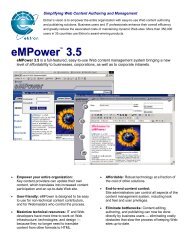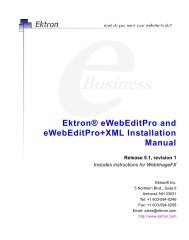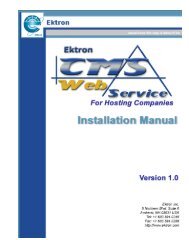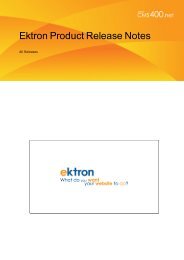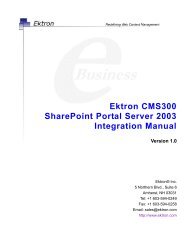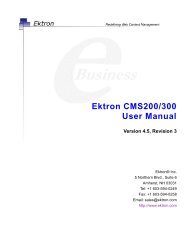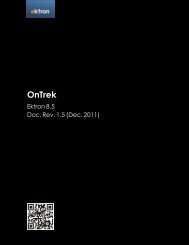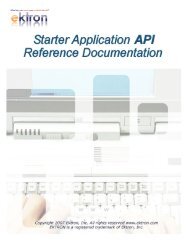Ektron Product Release Notes - WebHelp - Ektron
Ektron Product Release Notes - WebHelp - Ektron
Ektron Product Release Notes - WebHelp - Ektron
Create successful ePaper yourself
Turn your PDF publications into a flip-book with our unique Google optimized e-Paper software.
l Autosuggest, a search feature that suggests similar terms or common refinements that<br />
searchers have used in the past that are related to the search term. As a user enters<br />
text, possible matches appear<br />
Improved URL Aliasing<br />
<strong>Ektron</strong> has improved its URL Aliasing feature. <strong>Ektron</strong>’s URL Aliasing makes it easy to create<br />
descriptive, meaningful and SEO-friendly URL aliases consistently, maximizing your<br />
website’s placement in search results. Use of words and phrases that actually define the<br />
page can increase an aliases’ search engine rankings. If you follow a pattern, you can scale<br />
your aliases across your sites as they grow. Search engines find URL aliases generated by<br />
<strong>Ektron</strong>. <strong>Ektron</strong> caches aliases to improve your site's performance.<br />
URLs created in 8.5 migrate seamlessly to 8.6.<br />
You can create the following types of aliases:<br />
l Manual URL Alias—give a content block a unique name. You can assign several<br />
manual aliases to content then decide which one is the primary alias. If multiple alias<br />
types are provided for a content item, you can enter any alias into the browser address<br />
field to access that content.<br />
l Automatic URL Alias—create rules to be applied to the following types of CMS<br />
entities. When you add content to any of the following types, it inherits the URL alias<br />
rules.<br />
o Taxonomy—create an alias that is based on the taxonomy in your CMS by using<br />
the levels of the taxonomy plus the title of the page. Because the alias is based on<br />
taxonomy, you can have multiple aliases that have relevancy to multiple search<br />
criteria.<br />
o Folder—create an alias that is based on the CMS folder structure. Descriptive<br />
folder names and a well-organized folder structure makes a URL more relevant to<br />
the content’s actual location.<br />
o User—create an alias using the name of a user in the URL. For example, a friendly<br />
URL for Steve's profile page can be www.example.com/steve.<br />
o Group—create an alias using the name of a group to help make community pages<br />
within your <strong>Ektron</strong> website easy to remember and find. For example, a friendly<br />
URL for car enthusiasts would be www.example.com/cars.<br />
l Regular Expressions (RegEx)—create a URL match pattern that can redirect or<br />
transform a range of URLs with a single setting.<br />
l Site Alias—lets an existing site URL have more than one URL for the same site. For<br />
example, if your company‘s name just changed from Bionics to NewGen, (and the site is<br />
essentially intact), you can use site aliasing so your customers can get to the same site<br />
content from the old www.bionics.com address and the new www.newgen.com address.<br />
l URL Redirect Alias—lets a link to an old URL find the new or changed URL that you<br />
want. You use this alias when you need to add, change, or modify an existing URL.<br />
eSync Updates<br />
The following updates were made to eSync:<br />
Improved URL Aliasing<br />
l Content Dependency sync was improved. As of 8.6, Content Sync syncs content and all<br />
entities which have direct dependencies to it. This mostly refers to entities linked within<br />
<strong>Ektron</strong> <strong>Product</strong> <strong>Release</strong> <strong>Notes</strong>—All <strong>Release</strong>s 83


